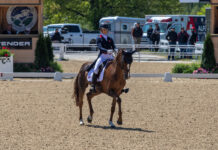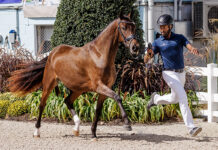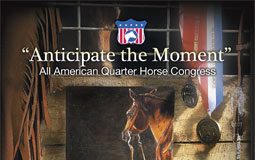Horses are experts of the swift getaway. When danger is perceived or fear is felt, instinct emblazons the word “PANIC” across the horse’s brain. His mind then commands his body to engage muscle, tendon, heart, and lung at maximum output. The result is the bolt, an immediate burst of speed on which prey animals rely for escape. If you find yourself a passenger on a horse using this flight tactic, you are in for quite a ride!
If you’re finding it challenging to remember that you’re fine when you feel your horse’s heft hastily accelerate, the first step in regaining his composure is quiet the alarm bells in your head. Letting anxiety rule the situation creates worry that will transfer to your horse. He’s scared enough as it is! Begin by taking deep breaths. Holding breath creates stiffness and intensifies your own fight/flight response. Sing the Star Spangled Banner or the ABCs. That will get air flowing into your lungs and help you and your horse calm down.
Then think about what’s happening from your horse’s perspective. He’s taking off because in that moment he’s convinced he’s going to die! Immediately shutting down his escape route intensifies the threat he feels, but it isn’t a feeling that lasts long. Watch a horse bolt in a pasture. His sudden burst of speed ends after a few strides. Once there is comfortable distance between the “lunging claws or gnashing fangs,” of his attacker (i.e. plastic bag or suspicious squirrel) he feels safer and even turns to look at what scared him.
Permitting those initial flight steps makes it easier for your horse to calm down, and reduces his resistance as you ask him to refocus his attention. So, instead of grabbing the reins and demanding a speedy halt to his shenanigans, redirect your horse’s bounding energy onto a circle or turn. Establish a solid yet elastic connection with your horse’s mouth by shortening both reins, but make one rein an inch or two shorter than the other – this is your turning rein. Pulse pressure on the turning rein with your fingertips in rhythm with the 3rd beat of your horse’s canter/lope or on the 2nd beat if he’s in a fast trot. Sit deep in the saddle with your heels down and core muscles engaged to increase your leverage and help you stay centered and balanced.
If you’re on a narrow trail and circling isn’t an option, shorten both reins and flex your horse’s head to the inside at the poll while keeping his neck relatively straight. Pulse pressure on your inside rein. At the same time open your outside rein and apply gently pressure with your inside leg at the girth or cinch while you add weight to your inside seat bone and twist your shoulders slightly to the inside – the direction toward which your horse is bending. This will shift your horse’s weight and gets him thinking more about what his feet and less about reacting to his environment. It also shifts his weight rearward and returns control of his body to you.
Singing to help you breathe (when we are nervous we hold our breath and become tense), and soothe your horse. Give your best rendition of the ABCs if nothing else comes to mind.
Then work toward regaining directional and psychological control of your motoring mount. Additionally, there is a good chance that your horse is trying to get away from something stationary; with every bolting step he is leaving it farther and farther behind. Thus, the threat is diminishing and he will soon feel less stressed and more capable of “hearing” you speak through your reins, voice, and legs.
Practice gaining control of your horse at speed in the safety of an arena. Teach your horse that it’s OK to pick up speed when you ask for it and increase your comfort with the idea of your horse going fast.
Liked this article? Here are others you’ll enjoy:
Video: What to Do When Your Horse Starts Bucking
How to Stop the Bolting Horse
Trail Riding Problem Solver
Dale Rudin is a CHA-certified riding instructor and clinician with a mindful and balanced approach to horsemanship and riding.
www.un-naturalhorsemanship.com







cool
Does anyone know why the horse’s head is in such a unnatural position. Most horses, in their nature riding or caring their head much higher. So how would this affect, if a horse does bolt.
Great advice if one’s horse is simply running fast. But I’ve known many horses who buck when they bolt and also twist and turn and it’s very hard to stay in the saddle. I don’t think they’re so scared but take advantage of the situation to remove their rider.
Good advice especially the singing. I had a bolting experience with my beloved horse caused by “unfortunately” standing on an ant hill. I turned to see what was troubling him just as he bolted, so I knew what caused the bolt. We were on a narrow path close to a railroad track and of all things a train was coming. I knew I had to stop him so I just started talking to him saying, “easy, easy boy” over and over while pulling and releasing the reins. I could feel him relaxing and slow down we stopped just in time to avoid a large ditch ahead and the train tracks. All ended well because I knew the reason for my horses fear was gone, stayed calm and that my horse trusted me.
I would like to say Thank You for the video on What to do when your horse bolts. It was very informative. My Dollar Boy tends to be a bit nervous at times. I hope I won’t need to use the information but it’s great to know how to handle the situation should it happen.
Why didnt she demonstrate on a horse that WAS bolting instead of barely a lope.
I find this bit of advice rediculous. A bolting horse is full of fear and not always in a nice open controlled area with great footing… if the horse spins to bolt you will be unseated to begin this trip. I think a more realistic approach needs to be shown. This was amusing
Any kind of info is helpful. Not every situation is the same. Thank you.
THATS FINE IN AN ARENA…..ON A NARROW TRAIL…CAN’T CIRCLE
Crank head to right as far as you can snd cover their eyes if u can. Got on a barn sour horse n she got me to end of road then decided to bolt, must have been her comfort zone at first. I was not a great rider, but I did exactly that n she stopped very quickly, I was shaken, had her owner get on her n continue riding her so she didn’t think acting up would get her back to barn.